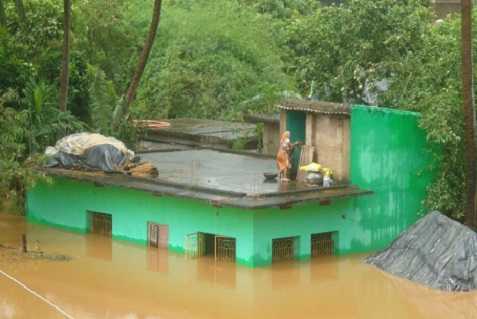
A woman stands on the roof of her flooded home in Balasore district, Orissa
Flooding in eastern India worsened on Wednesday as more than one million people were displaced when overflowing rivers submerged homes, days after Cyclone Phailin brought torrential rains.
Some 2,600 villages in Orissa state were submerged. At least 24 people died in the cyclone, the strongest to hit India in the past 14 years.
"The floods have cut road connections and communication and electricity lines in several places making rescue work difficult," said Arvnid Padhi, Relief Commissioner of the worst-affected district of Balasore.
The district has suffered particularly badly from the flooding because it is surrounded by three rivers that are all overflowing. In Balasore alone, around 950,000 people from 1,211 villages have been affected, with 100,000 people rescued.
"Army units and navy divers are assisting us in the rescue operation," Padhi said. Three other districts—Keonjar, Bhadrak and Mayurbhanj—have also been hit, he added.
The problems faced by flood victims are manifold, with reports of snake bites, and food and medicine shortages.
Many victims said officials had not warned them about the floods. Before the cyclone struck, government agencies evacuated some 50,000 people from coastal areas, reducing the impact of the disaster.
The strategy was born out of lessons learned from a cyclone that smashed into Orissa in 1999, killing around 10,000 people. Despite cyclone shelters being built prior to Phailin, “no such warnings or actions were seen ahead of floods," said Harish Chnadradas of Thangadia village.
"Water came rushing suddenly as it rained instantly," he said, adding that some 270 people in his village ran for their lives "without taking anything with them, not even spare clothing."
Houses were under two meters of water and most mud houses collapsed while others developed cracks. The standing paddy crop, villagers’ only source of income throughout the rest of the year, was also destroyed.
"I have no idea what to do for income. Maybe I will move out of the state to look for a job, or work on some farms as a laborer," he said.
Basanti Dalai, also of Thangadia village, said no government agency had come to help them. "We are on our own. No food, no clothes, no utensils. Children and women are staying together with men without any facilities for basic needs," she said.
Officials expect the situation to stabilize in two days as rains have stopped in upper catchment areas of rivers, reducing the flow of water. They also do not expect more water to flow into the river on Wednesday from a high tide, Padhi said.


